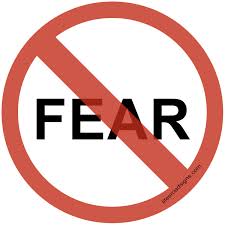 This is going to be, admittedly, an uncomfortable read for some. But, nonetheless it is a conversation we need to have. I need to discuss the “F” word. No, not THAT “F” word. The “F” word that is more dreaded than the F-bomb – Fear. Many first responders enjoy discussing fear as much as they enjoy discussing that other “F” word – feelings. Ironically, fear is a feeling. More accurately, fear is an emotion. And this emotion can save your life. It can also cost you your life.
This is going to be, admittedly, an uncomfortable read for some. But, nonetheless it is a conversation we need to have. I need to discuss the “F” word. No, not THAT “F” word. The “F” word that is more dreaded than the F-bomb – Fear. Many first responders enjoy discussing fear as much as they enjoy discussing that other “F” word – feelings. Ironically, fear is a feeling. More accurately, fear is an emotion. And this emotion can save your life. It can also cost you your life.
The Power of Fear
 One of my favorite classes to teach is designed to take the mystery out of understanding human motivation. It is a topic that has drawn my interest for decades. What compels people to do, or not to do, something? What causes some people to cower and run from danger while others charge head-first into risky situations with little concern for their safety or self-preservation?
One of my favorite classes to teach is designed to take the mystery out of understanding human motivation. It is a topic that has drawn my interest for decades. What compels people to do, or not to do, something? What causes some people to cower and run from danger while others charge head-first into risky situations with little concern for their safety or self-preservation?
I find the research in psychology and cognitive neuroscience absolutely fascinating. I am a self-admitted neuro-nerd. Yes, that’s a new term I just made up. But it is, sadly, what I have become. Fear is a powerful emotion. In fact, fear is one of only two emotions that compels all human behavior. The other emotion is desire. Reacting to fear motivation can be life-saving. Fear has helped us survive as a species.
Learning early in our existence to fear poisonous snakes or sabretooth tigers was pretty darned important. Thankfully, we learned to adapt and survive by listening to and responding to fear cues. Otherwise, we would be extinct. However, over time, what we have evolved to fear is surprising. It is something that will not cause us physical harm in any way. But the psychological harm can be enormous. This evolved fear is what I want to address here. It is, in many ways, a completely irrational and seemingly insane fear.
What Humans Fear
Human fears have been the focus of many research studies. It is a fascinating  area of research. Humans have evolved to be the dominate species on the planet so there are few creatures we need fear. We have also evolved complex weaponry that can help us overcome any foe (human or non-human). One might think the emotion of fear could subside or become extinct. This is hardly the case.
area of research. Humans have evolved to be the dominate species on the planet so there are few creatures we need fear. We have also evolved complex weaponry that can help us overcome any foe (human or non-human). One might think the emotion of fear could subside or become extinct. This is hardly the case.
What humans fear now is each other. But it’s not physical harm we fear so much. It is psychological harm. We have evolved into a social creature that values being liked and respected by our peers. Many humans fear anything that puts likability or respect in jeopardy. Ranking at the top of what humans fear is public speaking. In fact, the fear of public speaking consistently ranks higher than the fear of dying.
Think about how irrational this is. People fear giving a eulogy at a funeral more than they fear being the person in the box! This is simply not rational. Of course, many human fears are not rational. What is it about public speaking that people fear the most? If you take a moment to think about it, the answer should come to you. People have a:
- Fear of being seen as a failure
- Fear of consequence (getting into trouble or yelled at)
- Fear of being embarrassed
- Fear of being ridiculed by subordinates, peers, or superiors
- Fear of losing hard-earned respect
- Fear of not being liked by other people (and being shunned)
Ironically, these are the same fears that can compel someone to take excessive risks in the presence of excessive danger. The fear of dying has been replaced with these other fears.
The Pressure of Fear
The fears listed above are psychological fears, not physical fears. They, nonetheless, compel behavior. What happens when we bring those psychological fears onto an emergency scene? First responders operate in the presence of subordinates, peers, and/or superiors. When psychological fears loom, fear-avoidance thoughts begin to dominate behavior:
- I don’t want to be seen as a failure.
- I don’t want to get into trouble or yelled at.
- I don’t want to be embarrassed.
- I don’t want to be ridiculed.
- I want to be respected.
- I want to be liked.
When gripped by this mindset, the presence of critical clues and cues that form situational awareness of present dangers may be completely ignored. Fear is trumping safety, but it’s not the fear of dying or being injured. Rather those “other” fears – those fears not talked about in first responder circles.
Guilty as Charged
I am not proud to tell you I have been gripped by these  psychological fears. Peer, supervisor, and organizational culture pressures have caused me to take risks that I can only be thankful I am here to talk about. At the time, I gave little concern to my personal risk. In fact, when I was younger, I also suffered from another situational awareness barrier – the feeling of invincibility.
psychological fears. Peer, supervisor, and organizational culture pressures have caused me to take risks that I can only be thankful I am here to talk about. At the time, I gave little concern to my personal risk. In fact, when I was younger, I also suffered from another situational awareness barrier – the feeling of invincibility.
Yes, there was a time when I wore my underwear on the outside of my turnout gear and had a Superman mindset. This, coupled with the fears discussed herein, I was simply…dangerous. I was also very lucky. I see first responders who put decals on their helmets that say, boldly: NO FEAR. This is a tragic denial of basic human instinct.
When entering an environment that can kill you in an instant, there should be a healthy respect, and fear, for the power of environmental factors that are out of our control. There should also be a powerful respect for the fears discussed in this article because these fears can cause a responder to completely overlook – if not ignore – the critical clues and cues that indicate extreme danger.
Chief Gasaway’s Advice
 Acknowledge your fears. Discuss them with your subordinates, peers, and supervisors. There is way too much to lose if you are compelled to do something beyond acceptable risk levels simply because you are afraid of being seen as a failure, or criticized, or embarrassed. These fears are exceptionally dangerous because they can exist at all levels of an incident scene, from the newest responder to the incident commander.
Acknowledge your fears. Discuss them with your subordinates, peers, and supervisors. There is way too much to lose if you are compelled to do something beyond acceptable risk levels simply because you are afraid of being seen as a failure, or criticized, or embarrassed. These fears are exceptionally dangerous because they can exist at all levels of an incident scene, from the newest responder to the incident commander.
Commanders may not order responders to exit a dangerous environment because they fear being criticized or viewed as an inferior commander. Responders who are ordered out of an environment may push back by saying things like “we’ve almost got it”… “give us a couple more minutes”… or “we’re making progress”. What they may be really saying is: “Please…don’t order us out and make us face our peers and suffer the ridicule and criticism that we are not worthy of the task that was given to us.”
While I was facilitating a discussion on this topic during a class, I once had a firefighter say to me: “I would rather die than be ordered out of a burning building.” I was stunned into silence, as was the entire room. I could only think to myself: I wonder what the family members left to deal with the tragic loss would think about that statement?
Action Items
 Discuss the psychological fears that can compel you into performing unsafe actions in the presence of excessive risk.
Discuss the psychological fears that can compel you into performing unsafe actions in the presence of excessive risk.- Discuss, in advance of an emergency incident, how a peer, subordinate, or superior might effectively communicate concerns about conditions in a way that overcomes fear.
- Discuss strategies for how to help and support your peers to deal with psychological (social acceptance) fears.
About the Author
Richard B. Gasaway, PhD, CSP is widely considered a trusted authority on human factors, situational awareness and the high-risk decision making processes used in high-stress, high consequence work environments. He served 33 years on the front lines as a firefighter, EMT-Paramedic, company officer, training officer, fire chief and emergency incident commander. His doctoral research included the study of cognitive neuroscience to understand how human factors flaw situational awareness and impact high-risk decision making.
_____________________________________________________

If you are interested in taking your understanding of situational awareness and high-risk decision making to a higher level, check out the Situational Awareness Matters Online Academy.
CLICK HERE for details, enrollment options and pricing.
__________________________________
Share your comments on this article in the “Leave a Reply” box below. If you want to send me incident pictures, videos or have an idea you’d like me to research and write about, contact me. I really enjoy getting feedback and supportive messages from fellow first responders. It gives me the energy to work harder for you.
Let’s Get connected
Facebook: SAMatters
LinkedIn: Rich Gasaway
LinkedIn: Situational Awareness Matters
Twitter: Rich Gasaway
Youtube: SAMattersTV
itunes: SAMatters Radio
Stitcher Radio: SAMatters Radio
Google Play: SAMatters Radio
iHeart Radio: SAMatters Radio

